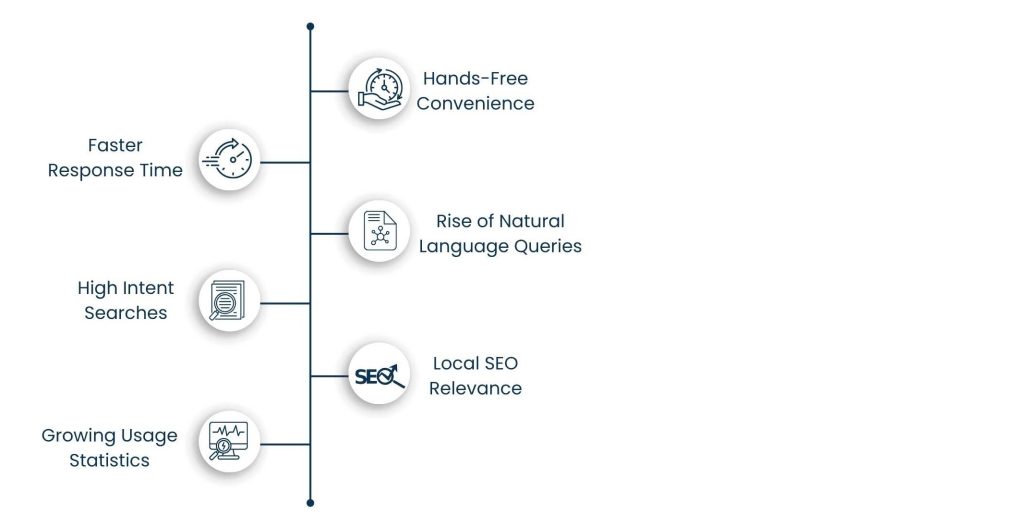Introduction
Voice search optimization is not a theory; it’s a practical thing happening around us day and night. Search is evolving by the second with smart assistants like Alexa and Google Assistant. Now they are asking full-sentence questions like, “Where can I buy eco-friendly detergent near me?” instead of typing short phrases. This is all about matching your content with people’s way of talking. Standards search engine optimization using traditional keyword methodologies isn’t enough any longer to survive in a voice-search world.
You should adapt voice search by using natural, more conversational language, answering users’ questions in a human-like dialogue, and using longer-tail keywords that mirror how people speak. It also involves local SEO,such as mobile responsiveness and loading time.
This presents a chance for businesses to promote themselves in a better way. Make your content voice assistant-friendly and easy to consume. That’s the terrific part about voice search optimization.
Why Voice Search Is Skyrocketing?
The organic feel of voice search is prompting voice optimization. People are busier than ever whether on their way to work, making dinner, or working out, pressing a few voice commands is just easier than typing it all out. Look no further than your voice assistants, whether they be Alexa or Siri, or Google Assistant, to get instant responses at your beck and call.

1. Hands-Free Convenience:
You don’t even need to unlock your phone or open an app. Say only a couple of words, and the assistant reacts at once. That simple nature is appealing, particularly for quick questioning or doing things while you’re multitasking.
2. Faster Response Time:
Utterance is faster than typing, naturally. Within a second, you can pose a full question and get a concise answer, often gleaned from featured snippets or direct-response content.
3. Rise of Natural Language Queries:
Instead of typing “weather London,” users now ask, “What is the weather in London this weekend?” These complete questions are more conversational and easier for voice assistants to interpret precisely.
4. High Intent Searches:
Voice search queries like “call a plumber now” or “book a table near me” tell us that the searcher has heightened purchase intent. When we optimize for these, we can increase the rate of conversion.
5. Local SEO Relevance:
A lot of voice queries are of the “near me” variety or are other location-oriented requests. It also opens a potent path for visibility and foot traffic for businesses that provide local services.
6. Growing Usage Statistics:
More than 50% of the world’s searches are now being made by voice. The proliferation of smartphones and home assistants makes it likely that the number will rise further.
In other words, voice search is not a trend that is going away. It’s becoming a default behavior. Brands that recognize and adapt to this change and have content that is voice optimized for things like conversational tone, local SEO, and providing clear answers, for instance, will not only be in the mix of results returned but will be trusted, instant answers.
Main contrast between Text and Voice Search
To properly conduct voice search optimization, however, the first step is to understand how voice search differs from traditional search, that is, text-based search.

These variations also guide your content strategy, informing you of how you should be producing content:
1. Conversational Tone:
People give commands to voice assistants in the way they talk to friends, informally and naturally. Instead of “best laptop 2025,” they ask, “What’s the best laptop to buy in 2025?” It means the content you produce should follow that tone as well.
2. Use of Long-Tail Keywords:
Voice searches are longer and more detailed. Instead of short keywords, optimize for voice calls for targeting phrases such as “how to file taxes as a freelancer in California.” These longer keyword phrases mirror the way users word their verbal queries.
3. Question-Based Queries Dominate:
The majority of voice searches are initiated with words like “how,” “what,” “best,” “where,” and “can.” By structuring the content so that you are able to immediately answer those questions, you will have a higher chance of being pulled as a voice search answer. Examples include “What’s the best way to learn French? Needs to be answered directly.
4. Strong Local Intent:
Voice searches tend to include “near me” searches or the name of a place. Queries such as “best sushi restaurant near me” or “24-hour pharmacy open now” are demonstrating this behavior. It’s one of the reasons local SEO is so important in a voice-first world.
By recognizing these differences, you can create the content that gets closer to how real users talk, and then your site has a better chance of ranking when someone utters into their phone or a smart device.
Top Voice Search Optimization Strategies

1. Use Conversational Language
Voice searches are different from typed searches in that they are conversational. Users aren’t typing “Italian restaurant Manhattan”, they’re asking something like, “What’s a good Italian restaurant in Manhattan that’s open right now? This shift requires that your content become a little less like a computer-generated Words on Screen program and a bit more like a human speaking.
To fit this tone, write as people naturally speak.” Prefer clear, simple, and easy to follow sentences. You can use contractions, like “what’s” and “I’m,” and respond to the questions as if you are having a conversation. This establishes trust and helps acclimate voice assistants to be able to serve up the correct response.
Example:
Typed: “best running shoes 2025”
Voice: “What running shoes are best to purchase in 2025?”
Turn your content into spoken words to increase the likelihood that digital assistants will choose your answer in voice responses.
2. Target Long-tail Keywords and Questions
Voice search optimization focuses on long-tail keywords, the more detailed, the better. When people speak to their devices, they tend to speak in full questions or phrases rather than short combinations of keywords. For instance, people might ask, “What are the tax deductions I can claim as a freelancer in 2025?”
These complete queries indicate user intent. That’s why adding question-style headings and answers that mimic the way people talk throughout your text can be a good reflection. You can find these questions by using search tools such as Google “People Also Ask”, Answer The Public, or your search console analytics data.
Get more imaginative with keywords, think about how your perfect customer would pose the question out loud. Then write in that language, straightforwardly and plainly, throughout your text. It’s not about ranking at all; it’s about being the answer they hear when they ask their smart device a question.
3. Create an FAQ Section
One of the simplest ways to enhance voice search optimization is the development of a dedicated FAQ area. Why? For the reason that most voice searches are questions, Google likes content with straightforward answers to questions in an easy-to-skim format.
Begin by noting the most commonly asked questions from your audience. The similar search trends will be all over your customer service logs and keyword research tools. Then, flesh out a new FAQ section on your page, where you straightforwardly ask individual questions and give useful answers.
This doesn’t just make things clearer but also increases the likelihood of you appearing in Google’s search. It’s a clever way to nab some high-intent, relevant voice search queries.
4. Focus On Earning Featured Snippets
Voice assistants read aloud featured snippets, brief highlighted answers on top of the SERP. Your content needs to be clear, concise, and think of it as when you’re answering a question on a game show, the more quickly and precisely you answer, the better.
Start by finding voice-friendly queries in your niche. Then frame those questions as headlines, and below each, you will offer quick (factual, not promotional) answers in 40 to 50 words or fewer. Put it in list format like this, such as bullets, numbers, or whatever.
Avoid awkward keyword stuffing and, when applicable, use schema markup (ex, FAQPage or HowTo) to make it easier for the search engines to understand your content. You also want to make it as easy as possible for Google to pluck your answer and deliver it as the “spoken answer” to voice search queries.
It’s about clarity, structure, and value, all provided in a format suited for voice.
5. Improve Local SEO
Local content is very important in voice search optimization. The majority of voice utterances are location-driven, as in “pizza place near me” or “best dentist open now in Chicago.” And if you’re a local-serving business, you have no excuse not to optimize for local search.
Begin by claiming and optimizing your Google Business Profile, making sure the name, address, phone number, hours, and services are updated regularly. Check that your NAP details are consistent everywhere you are listed.
Incorporate the city or neighborhood into your keywords naturally in your content. You may also add location-based questions and answers to your website, such as, “Where are good, low-cost legal services in Austin?”
Ask happy customers to write up a little review, ratings are often the deciding factor when local companies are presented online, on a voice assistant.
And when your local SEO is on point, voice searches with local intent can often do more than drive clicks: They can get real feet into your door.
6. Ensure Fast, Mobile-Friendly Performance
“How fast and mobile-friendly your site is” is important for voice search optimization. That’s because most voice searches occur on mobile devices and users demand answers in seconds. Voice assistants will not recommend it if your website is too slow or difficult to use on a phone.
First of all, see how your site is performing on platforms like Google PageSpeed Insights or GTmetrix. Then work on image compression, remove scripts, and use a lightweight responsive theme to help optimize your site’s performance.
Your website needs to load in no more than 3 seconds. More gradually than that, and your content could begin to fall behind in voice search consideration. And of course, ensure your design works perfectly on all screen sizes. Buttons should be pressable, fonts should be readable, and menus should be just as easy to see and use while on the go as they are when we’re not moving.
And don’t skimp on HTTPS, Google is a fan of secure websites, and that counts in voice rankings, too.
In short, fast and mobile-friendly isn’t just good UX, it’s now central to the push to be voice-search ready.
Structuring Content for Voice Assistants
The content is only part of the equation for successful voice search optimization; it’s also about how you structure it. They read and deliver spoken responses based on crisp, properly formatted content.

Here’s how to adapt your content for a voice-activated world:
1. Write short sentences in plain language
Voice assistants handle content read aloud, so your writing should be easy to understand upon initial reading. Stay away from long sentences, fancy language, or jargon. Think about how you would explain to a friend, naturally and clearly.
2. Break content into clear headings
Organize your page using H2 and H3 tags. Orient each heading toward questions that people may be asking when they search: questions like “How does this work? or “How do I get started best?” It is beneficial for SEO and user experience as well.
3. Begin each section with a brief description
Give me the first 1–2 lines under a new subhead that answer the above question directly in 30–50 words. Voice assistants favor a brief, easy-to-read answer they can immediately spit out.
4. Add schema markup
Utilizing schema types such as “FAQ Page” or “How To” helps search engines understand your content more accurately. Schema gives you a leg up on that voice optimization in featured snippets and other helpful formats.
5. Use a conversational tone
Write as people talk. Use contractions. There was never a robot that read a phrase stiffly. It’s a pitch that matches the way people talk to their devices and the way voice assistants respond.
6. Use lists and bullet points to organise content.
Lists are a useful way to structure content for both readers and voice bots. Use them to chunk out steps, features, or key takeaways in a scannable manner.
When you adhere to these structural rules, your material also becomes more easily available to voice-activated search. It’s not just a matter of being informative; it’s about being easily understood, easily found, and naturally spoken by digital assistants.
How Voice Search is Impacting Various Industries?
Voice search is not confined to one industry — it is disrupting the way consumers are interacting with businesses across almost every industry. By insight into the kind of queries people enter by voice, you can adjust your strategy to help them where they are, usually in mid-conversation with a smart device.

1. E-commerce
Voice searches of the type “What’s the cheapest Bluetooth speaker available at this time?” are incredibly common. Shoppers use voice to compare prices, perform product reviews, and even order things hands-free. But if your product listings and descriptions are not voice-friendly, then you are probably losing out on purchase-ready users right now.
2. Healthcare
Questions like “Which clinic is open near me right now?” demonstrate the importance of voice for more pressing matters. Local SEO, hours of operation, and current Google listings are extremely influential in making sure your clinic or practice shows up when someone needs help immediately.
3. Hospitality
Here, a user might say, “Book a hotel room in Miami for this weekend.” These searches are also goal-directed, time-limited. For hospitality brands, their booking systems must be mobile-responsive and also feature in local and travel-based voice searches.
4. Estate
“For those people who are looking to buy or rent, one of the most common questions we get is, ‘What is the best school system in Houston?’ These are of the location, quality of life, and a comparison form of voice search. Real estate companies could create voice-optimized content that answers buyer questions in targeted markets.
5. Education & Online Courses
Voice search questions such as “What is the best course for digital marketing for beginners?” are rising. If you’re an educational platform, ensure you are maximizing for such course-related questions and offer the best, to-the-point answer in your resources.
6. Food & Beverage
Commands such as: “Best vegan restaurants near me” or “Order pizza for pickup.” Restaurants that invest the time in voice-optimized local SEO as well as menu-listing integrations with Google and Yelp will have a competitive advantage.
No matter what your business does, voice search is influencing how your customers behave and how they choose.
How to speak and be spoken of: Presence and clarity in voice search results build trust and encourage action.
Conclusion: The importance of Voice Search Optimization right now
Smart voice search optimization is no longer a passing trend of the future; it is already feeding power to the way people search, shop, and decide on things. A large number of users depend on voice assistants such as Alexa and Siri every day. The intention is clear: consumers want accurate and conversational responses.
The businesses that absorb and adjust to this paradigm will have a leg up. It’s no longer about ranking on Google; it’s about becoming the spoken answer. That includes writing content that reflects the way people talk, targeting long-tail keywords, and delivering structured and digestible information.
Whether someone is inquiring about your store hours, seeking services “near me,” or searching for advice in their own words, your content has to be ready to answer. Voice search delivers users with intent directly to your digital doorstep. The real question is, will they find your brand when they arrive?
Begin optimizing for voice today because your customers are already talking. It’s about time your content learned to answer it.
About Us
Tasks Expert offers top-tier virtual assistant services from highly skilled professionals based in India. Our VAs handle a wide range of tasks, from part time personal assistant to specialized services like remote it support services, professional bookkeeping service etc. Furthermore, it helps businesses worldwide streamline operations and boost productivity.
Ready to elevate your business? Book a Call and let Tasks Expert take care of the rest.










